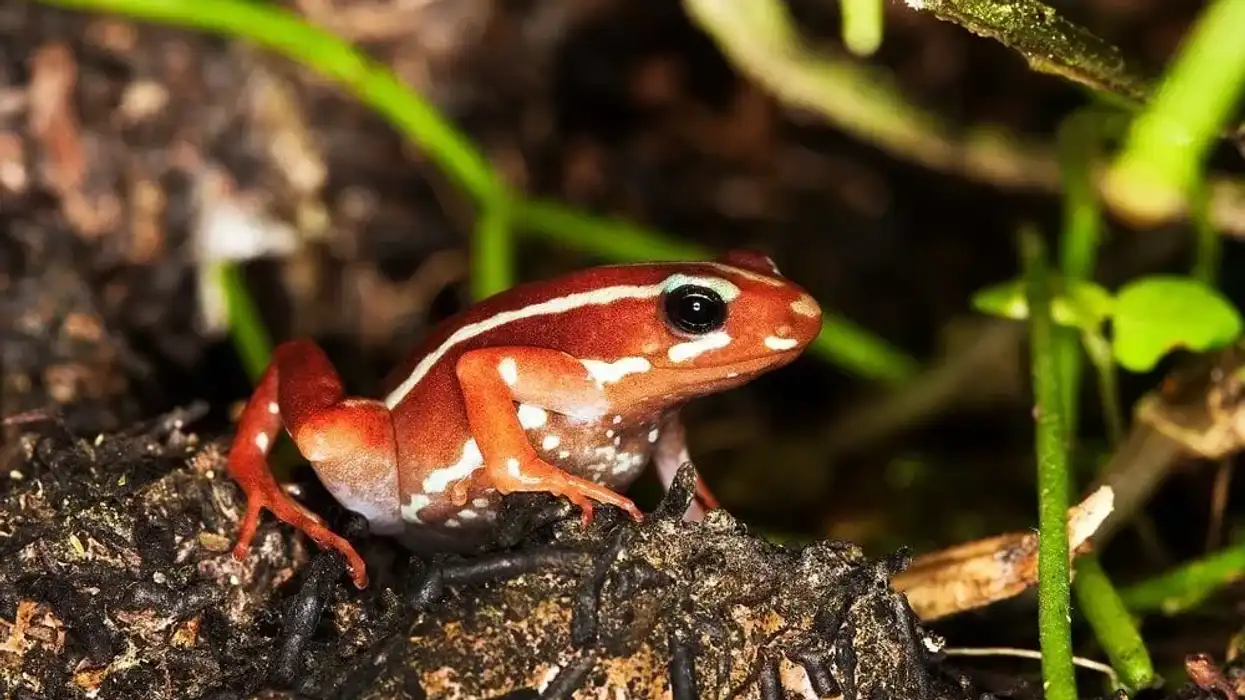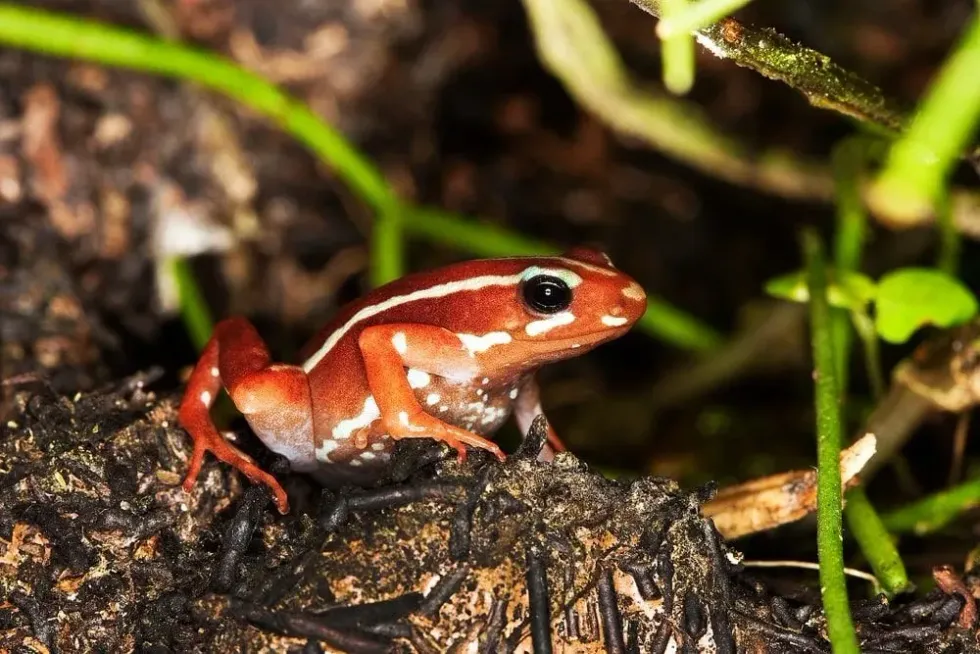Forests are home to unique amphibians.
Phantasmal poison frog is a member of the poison frog family. As the name suggests, these frogs are poisonous.
A species of frog lives on the Andean Slopes of Central Ecuador. The brightly coloured frogs with green bones are extremely dangerous. Because of its poisonous diet, the phantasmal poison frog has a deadly toxin on its skin.
As a result, if you come across one in the forest, you should not touch it. Aside from the seven or more locations where this poison frog can be found, you can also find it at your local zoo. Don't worry, a phantasmal poison frog's zoo diet is not poisonous.
There are numerous fascinating facts about this poison dart genus. Males, for example, carry tadpoles on their backs and deposit them in the nearest body of water. The current forest populations face numerous man-made threats such as banana plantations, aquaculture, and so on.
It is time to learn more about this poison frog family member!
Phantasmal Poison Frog Interesting Facts
What type of animal is phantasmal poison frog?
The phantasmal poison frog (E. triolor) is a member of the poison dart group.
What class of animal does a phantasmal poison frog belong to?
This member of the Dendrobatidae family group is an amphibian.
How many phantasmal poison frogs are there in the world?
The number of mature phantasmal poison frog (poison dart frog) present in the wild and zoo around the world is unknown.
Where does a phantasmal poison frog live?
The dart frog phantasmal poison is a native species found in the natural forests and wetlands of Central Ecuador. In the wild, it can survive in elevations ranging between 1968.5-5807.1 ft (600-1770 m).
During its endangered conservation status, these predators could only be found in seven localities. However, the population has grown and spread to as many as 20 localities. The phantasmal poison frog locations are on the Andean slopes in the Cotopaxi province and Bolívar province of Central Ecuador.
What is a phantasmal poison frog’s habitat?
The tricolor frog's habitat includes inland wetlands and forests, especially in montane forests around water bodies. These amphibians can be found on the forest floor and wetland among the leaf litter.
The frog phantasmal poison can also be found in fragmented patches, however, will be missing in severely damaged wild habitats. In a zoo, artificial conditions of its wild habitat are mimicked.
Who do phantasmal poison frogs live with?
Phantasmal poison frog does thrive in groups. However, males tend to be very territorial and will defend their spaces.
How long does a phantasmal poison frog live?
It is unknown how long a phantasmal poison frog survives in the wild. In the zoo, its life expectancy tends to be around 15 years.
How do they reproduce?
These poison dart frogs have sexual reproduction. According to the data, the female will lay about 10 eggs. During the mating season, the males fight to gain attention of females.
They also have specific mating calls. After mating, the females will lay 10-30 eggs underneath a leaf.
Males take care of the eggs under the leaf litter. Once the eggs hatch in the leaf litter, the males will carry the tadpoles on their back to the nearest water source. The phantasmal poison frog life cycle is complicated and the tadpoles will take around two weeks to grow into their adult replicas.
What is their conservation status?
According to the IUCN, the current conservation status of the E. tricolor is Vulnerable. However, in 2004, the conservation status was endangered. But the populations are constantly falling due to rampant habitat loss. The phantasmal poison frog habitat is threatened by agricultural and aquaculture expansion, wetland pollution, hunting, and so on.
Phantasmal Poison Frog Fun Facts
What do phantasmal poison frogs look like?
The phantasmal poison frog physical description has smooth skin and a truncated snout. The eyes are far away from the snout compared to the nostril. In the webbed toes, the second finger is smaller compared to the first finger.
Compared to other poison frog species, the E. tricolor has green bones and the body has a striped pattern. In terms of color, this group has a dark red to the brown body.
Yellowish-white stripes cover the dorsum, black marbling on the center, and red spots on the hind limbs. The cool part is that the stripping pattern on the skin varies from individual to individual. Also, the bright colors on the poison dart acts as a warning to predators.
How cute are they?
If you like bright and colorful amphibians, then you may find the phantasmal poison frog (Epipedobates tricolor) cute. Even baby tadpoles of this genus can look cute. However, the poisonous toxin (epibatidine) present on their skin makes them dangerous to touch.
How do they communicate?
The phantasmal poison frog behave or communicate by making calls or chips. These diaurnal species of amphibians make these calls during the day.
According to a study, the phantasmal poison dart frog makes longer and stronger calls when sitting on a perch compared to when on ground. The quality and the duration of these calls may vary during the mating season. The phantasmal poison frog when threatened acts out with its entire body.
Males will stand up and circle each other to push the other male on the ground. This aggression is visible during the phantasmal poison frog reproductive season.
How big is a phantasmal poison frog?
The phantasmal poison frog physical traits show it to be a small-sized frog. This species of frogs is estimated to be around 0.4- 1.6 in (1-4 cm) in size. This is really small compared to the Goliath frogs who are considered the largest frogs.
How fast can a phantasmal poison frog move?
The speed at which the phantasmal poison frog moves is unknown. However, the phantasmal poison frog uses saltation to move from one spot to another.
How much does a phantasmal poison frog weigh?
The weight of the phantasmal poison frog is estimated to be between 0.004-0.02 lb (2-10 g).
What are the male and female names of the species?
Both sexes of these amphibians would be referred to as phantasmal poison frog (Epipedobates tricolor).
What would you call a baby phantasmal poison frog?
The baby phantasmal poison dart frog (Epipedobates tricolor) would be referred to as tadpoles.
What do they eat?
Like other species of poison frogs, the phantasmal poison frog food contains insects, especially poisonous ones. This poisonous diet is what results in the formation of epibatidine (toxin), making these species of poison frog quite dangerous. However, the phantasmal poison frog zoo amphibians are given a different diet, which ensures that they are not poisonous.
Are they poisonous?
Yes, this species of poison frog (Epipedobates tricolor) is also very poisonous. It produces a toxin-epibatidine.
This alkaloid is highly toxic and only a small amount (2 μg) is enough to kill humans really quick when touched. The phantasmal poison frog toxin (epibatidine) on the skin of these predators is the result of their diet.
It is a sum of the toxins taken from insects like ants and so on, which accumulates in the glands of the phantasmal poison frog Epipedobates tricolor's skin.
Would they make a good pet?
While the phantasmal poison frog is part of the pet trade, it is not advisable to keep the phantasmal poison arrow frog due to it being poisonous.
Did you know...
Boulenger in 1899 provided the original description for phantasmal poison frog (Epipedobates tricolor).
Epibatidine is a painkiller made from the substances found in phantasmal poison frog (Epipedobates tricolor).
How did phantasmal poison frogs get their name?
It is unclear how phantasmal poison frogs got their name. However, poison frogs are known so because of the poison found on their skins. Sometimes, these endangered species are also known as poison dart frogs.
This is because the Choco tribe from West Columbia used to coat their darts with the poison found on these amphibians. These poisonous darts where then used to hunt animals. They used to pick the frogs with a leaf and coat their darts.
Are phantasmal poison frogs endangered?
No, the phantasmal poison frog is not endangered. According to IUCN, the population is Vulnerable and declining.
Habitat loss is the main reason for this. The phantasmal poison frog which is native to Ecuador is found near wetlands that are constantly being destroyed or repurposed for human uses like agriculture and aquaculture. These frogs are also being overharvested for medicinal purposes and pet trade.
There are no official records of its conservation in protected areas. There is a need to protect the landscape from further habitat fragmentation, degradation, and destruction.
*We've been unable to source an image of a phantasmal poison frog and have used an image of poison dart frog instead. If you are able to provide us with a royalty-free image of phantasmal poison frog, we would be happy to credit you. Please contact us at hello@kidadl.com










